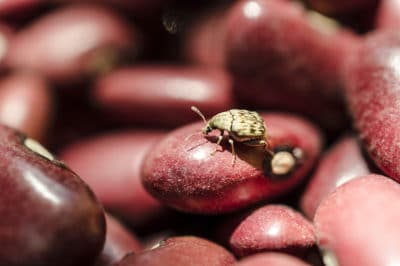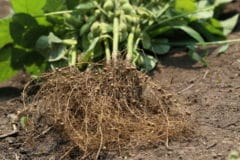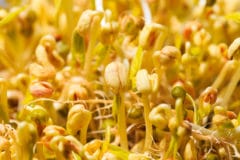Mexican Bean Beetles
The Mexican bean beetle is a relative of the ladybird beetle (ladybug). Unlike its relative, however, this yellow/copper brown beetle eats only legumes. Both larvae and the adults eat bean leaves, with an occasional foray into the pods themselves. The adults winter over and will reappear within a couple of weeks of warm weather. After feeding for a week or two, females begin to lay eggs.
Cowpea Seed Beetles
Although sometimes called bean weevils, these insect pests are actually members of the beetle family. Pupae winter over in mature dry beans and begin to hatch once the weather warms. Adult beetles live about two weeks. Cowpea seed beetles will attack other legumes and often show a preference for the type of bean in which they pupate.
Geographical Distribution
The Mexican bean beetle, as the name implies, probably originated in the highlands of Mexico. However, it is a significant pest in the southwest and states east of the Rocky Mountains. The cowpea seed beetle is native to West Africa, but has become widely distributed due to trade in legume crops. It is less likely to occur in colder climates where winter freezing occurs.
Methods of Control
Organic gardeners can use various methods of control. You can:
- Handpick adult beetles and larvae; crush or drop in soapy water.
- Dust beetles with diatomaceous earth.
- Release predator species to eat or parasitize the beetles.
- Spray with soapy water (cover top and bottom of leaves).
- Use botanical insecticides such as pyrethrins, nicotine, neem oil or ryania.
Keep It Clean
Garden sanitation is one of the best methods of keeping both these beetles under control. Remove all vines after harvest. Clean up any dried beans that have fallen on the ground. If you know you have either of these pests, the vines and beans should be burned. During the growing season, manually remove any leaves that have the yellowish egg clusters of the Mexican bean beetle.
Manipulate the Environment
Bean beetles often prefer certain types of beans. Mexican bean beetles like bush beans better than pole beans. Cowpea seed beetles prefer black eyed peas, mung beans and adzuki beans; if you have this beetle, avoid these crops. Plant favas, which are a cool-season crop and are ready before beans emerge. Plant favorite varieties as trap crops, remove and destroy the infested plants and then plant your main crop.












